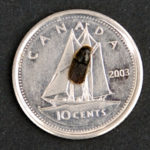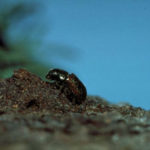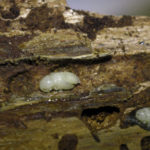From the point of view of Spruce Beetles, these are good times! It’s a time for growth, expansion, and the fulfilment of their purpose in the great cycle of life. The white spruce have matured, the winters have been mild, and it is time to feast, multiply, and thin the forest to make room for hardwood. However, from the human point-of-view, things are a bit different…
 The mature forest of white spruce that surrounds my home and spreads through the hills of Castle Bay have a visitor. And it’s not a welcome one.
The mature forest of white spruce that surrounds my home and spreads through the hills of Castle Bay have a visitor. And it’s not a welcome one.
Fifty years ago, there was barely a tree to be seen as the land was cleared for farmland and pasture. As farmers abandoned the land for jobs in the city, white spruce took hold and, in 50 years, the landscape was transformed to shady forests of tall, mature spruce. You can see this pattern repeated throughout Nova Scotia, resulting in many stands of even-aged, white spruce forests.
White spruce grows fast and is short lived. At 50 years, the trees are mature, rot can set in, and they are susceptible to being blown down in high winds. They are also vunerable to disease and attacks by insects.
Enter our guest–the simply named Spruce Beetle (Dendroctonus rufipennis Kirby), an insect native to Nova Scotia.
Last year, I noticed that some trees in the surrounding forests were turning brown. By this summer, the number of trees turning from healthy, vibrant green to brown has tripled. It’s not a gradual thing with a branch dying here and there–the whole tree dies.
Early in May, Spruce Beetles bore into the spruce’s bark, right down to the outer layer of sapwood. Here they mate, lay their eggs, and the feasting begins. When the larvae hatch, they eat together for a while and then go on their own, forming tunnels that soon ring the tree, preventing nutrients from flowing, and quickly killing the tree.
The adult beetles leave the tree in the fall and seek out a place to overwinter at the bases of the trees. If it’s a cold winter, keeping the beetle population low, the trees are able to resist their attack. Younger, healthy trees can produce additional sap to counter the attack, but when the trees are at the end of their life cycle, and the Spruce Beetles are plentiful–resistance is futile!
So how do you know if the Spruce Beetle has taken up residence? Watch for small holes about 1 mm in diameter that may have sap dripping out of them, or dried sap covering the holes. Watch for reddish- brown sawdust on the bark and the base of the tree. If you notice the tree turning reddish brown in late summer, it’s too late.
So what can you do? Unfortunately, very little. Harvest the spruce trees before they become over mature, remove trees that have blown down, don’t leave tall stumps and thick slash when harvesting. Harvest infested trees and remove them from the forest, destroy bark and slabs. Because most white spruce trees grow in same-aged stands, all of the trees may need to be cut.
Harvested logs should be placed in water to kill the remaining beetles.
From the human perspective, the attack of the Spruce Beetle is a costly nuisance. But it is nature’s way of preparing the forest for its next phase, and from the Spruce Beetles’ point-of-view, it is time to feast, multiply, and fulfil their purpose in nature!
From UINR Marten – Vol.3. Issue.3 – Autumn 2007



